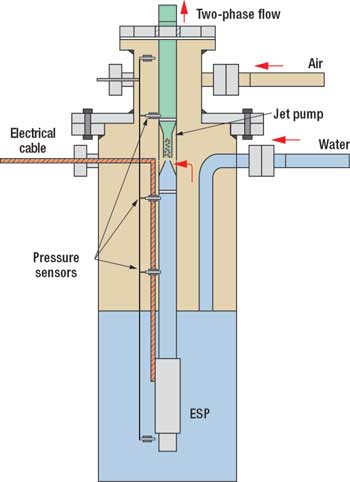What's new in production
A new design for pumping multiphase fluids.
A new direction in multiphase flow – early separation. While researching multiphase devices and ways to handle multiphase flow, I came across an interesting patent for an artificial lift system that combines an electrical submersible pump (ESP) and a jet pump (JP) in the same production string. The system has been patented under US patent 6,497,287 by Dr. Augusto Podio, Paulo de Carvalho and Kamy Seehrnoori. The essence of the design is to impart additional energy to a wellsteam through an ESP, but include a rotary gas separator (RGS) and jet pump to overcome the ESP gas-lock problem. The system is aimed at deepwater offshore wells where wellhead flowing pressures must be maintained at a high level to overcome high frictional losses and hydrostatic head. Such wells must often be shut-in early, which reduces a well's ultimate recovery. In the late 1990s, University of Texas researcher Paulo de Carvalho worked out a way to overcome this problem by inverting the normal flow through a jet pump. Instead of adding gas as the working fluid, the well's produced liquids serve that end and pulls free gas up the well. The system's operation is straightforward, Fig. 1. The electric submersible pump with a RGS at its base is placed in the well's liquid phase, while the jet pump is positioned higher in the production tubing. The RGS removes free gas from the produced fluids and releases the gas to the production tubing's annulus. This prevents gas-lock and allows the ESP to send the liquid phase up separate tubing to the JP nozzle.
The well's free gas pressurizes the production tubing annulus and recombines with the liquid phase at the JP nozzle's venturi. The resulting thoroughly mixed, two-phase flow can then be sent through flowlines to a processing facility. This arrangement allows the reservoir to slug gas without minimizing the effectiveness of the ESP. It also preserves gas energy, as the two phases are recombined through the jet pump. Other multiphase pumps along the flowline keep the flow moving. This system could be useful for deep offshore wells and could be very effective for marginal wells onshore that are producing significant gas along with oil. The advantages for offshore wells are compelling for some marginally productive wells. Using such a system could open additional satellite reservoirs that are not producible at present due to insufficient wellhead pressure. A prototype of the system was tested in a shallow well at the University of Texas with good results. According to Dr. Podio, the patent was under license to Weatherford for a time, but is presently available for further development. Shale oil research. Chevron and Los Alamos National Laboratory have created a joint research project to improve oil recovery from shales and other heavy oil deposits. Research will focus on Piceance basin oil shale formations in Colorado, US. The work will include reservoir simulation and modeling, as well as experimental validation of new recovery techniques, including a form of in-situ processing that could reduce greenhouse gas emissions. Chevron plans to use a 160-ac lease in the Piceance basin from the Bureau of Land Management's research, development and demonstration leasing program. The US holds 2 trillion barrels of oil shale resources, according to US Geological Survey estimates. Most of that potential is in the states of Wyoming, Colorado and Utah. New Brazilian production. Petrobras will start production from its P-34 rig in the Jubarte field, which will produce up to 60,000 bopd. In addition, the FPSO Cidade do Rio de Janeiro will soon begin production in Espardarte field. That vessel's production capacity is 100,000 bopd. This month Petrobras produced 1.9 million bopd from Brazil, a new record. Once additional platforms come on line, the company expects its daily Brazilian output to top 2 million bopd. The company plans to bring two production platforms online in Roncador field, offshore Campos basin, next year. The P-52 will start producing 180,000 bopd and compressing 328.4 MMcfd (9.3 MMcmd) of natural gas in early spring. Another platform, the P-54, will come online in early summer next year. That system is designed to produce 180,000 bopd and compress 212 MMcfd (6 MMcmd) of natural gas. In a related development, Petrobras will build a GTL test plant with the company, Compact GTL, to convert associated natural gas into synthetic fuel. The plant will be built and tested onshore, but it will ultimately become a floating system for offshore use. Petrobras presently re-injects or burns associated gas. Petrobras discovered more oil in the Santos basin, offshore Brazil. The Tupi discovery well flowed 4,900 bpd of 30° API oil and 4.3 MMcfd of gas on a 5/8-in. choke. The productive zone is from a deep pre-salt reservoir in Block BM-S-11. Earlier in 2006, BG Group found oil 70 km away in Block BM-S-10, which is on trend with the Tupi well. Petrobras is operator with 65%, while BG Group has 25% and Petrogal holds 10%.
|
|||||||||||
- What's new in production (February 2024)
- Prices and governmental policies combine to stymie Canadian upstream growth (February 2024)
- U.S. operators reduce activity as crude prices plunge (February 2024)
- U.S. producing gas wells increase despite low prices (February 2024)
- U.S. drilling: More of the same expected (February 2024)
- U.S. oil and natural gas production hits record highs (February 2024)





